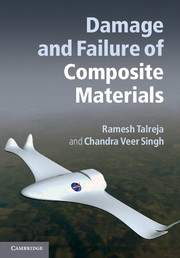Book contents
- Frontmatter
- Contents
- Preface
- 1 Durability assessment of composite structures
- 2 Review of mechanics of composite materials
- 3 Damage in composite materials
- 4 Micro-damage mechanics
- 5 Macro-damage mechanics
- 6 Damage progression
- 7 Damage mechanisms and fatigue-life diagrams
- 8 Future directions
- Author index
- Subject index
- References
4 - Micro-damage mechanics
Published online by Cambridge University Press: 05 July 2012
- Frontmatter
- Contents
- Preface
- 1 Durability assessment of composite structures
- 2 Review of mechanics of composite materials
- 3 Damage in composite materials
- 4 Micro-damage mechanics
- 5 Macro-damage mechanics
- 6 Damage progression
- 7 Damage mechanisms and fatigue-life diagrams
- 8 Future directions
- Author index
- Subject index
- References
Summary
Introduction
As explained in the previous chapter, damage affects the overall stress–strain response of the solid continuum body. Damage mechanics pertains to the study of this effect. Two widely different subfields have emerged over the years in this field. One concerns study of damage directly at the scale of formation of cracks, i.e., the microstructural scale, and hence can be called “micro-damage mechanics” (MIDM). The other approach, on the contrary, looks at the overall response at the macro or structural scale by using some internal variables to characterize damage, and thus can be termed as “macro-damage mechanics” (MADM). These terms were originally coined by Hashin [1]. MADM is the same as “continuum damage mechanics” (CDM), which is still the commonly used terminology.
MIDM for composite materials is derived from an older and more mature field called micromechanics that deals with overall properties of heterogeneous materials (see, e.g., [2]). In micromechanics one views heterogeneities such as inclusions and voids as “microstructure” and estimates overall properties by various methods, e.g., averaging schemes such as self-consistent and differential schemes, or variational methods to obtain bounds to average properties. Microcracks are treated as limiting geometry of microvoids, such as ellipsoidal voids with one dimension much smaller than the other two. As illustrated in the previous chapter, “damage” in composite materials has significant complexities concerning the geometry as well as evolution characteristics such as multiplication of cracks within a fixed volume. For these reasons a simple extension of micromechanics to damage in composites is generally not possible. A separate field identified as MIDM has therefore emerged. This chapter will treat the features of MIDM that have been developed to specifically treat certain cases of damage in composite materials. Since determining local (micro-level) stress or displacement fields is a necessary feature of micromechanics, it is expected that not all cases within the wide range of damage in composites can be handled by MIDM. However, this limitation can be alleviated by incorporating computational solutions of the local stress or displacement fields, thereby broadening classical micromechanics to include so-called computational micromechanics. In the most recent versions of MIDM this strategy has been used. More on this will be discussed toward the end of this chapter.
- Type
- Chapter
- Information
- Damage and Failure of Composite Materials , pp. 57 - 133Publisher: Cambridge University PressPrint publication year: 2012



